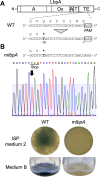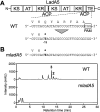Identification of a critical gene involved in the biosynthesis of the polyene macrolide lavencidin in Streptomyces lavendulae FRI-5 using the Target-AID (activation-induced cytidine deaminase) base editing technology
- PMID: 40261024
- PMCID: PMC12093942
- DOI: 10.1128/aem.00975-24
Identification of a critical gene involved in the biosynthesis of the polyene macrolide lavencidin in Streptomyces lavendulae FRI-5 using the Target-AID (activation-induced cytidine deaminase) base editing technology
Abstract
Polyene macrolide antibiotics, produced mainly as secondary metabolites of streptomycetes, have distinct chemical structures and include clinically important antifungal drugs. We recently isolated the 28-membered polyene macrolide lavencidin from Streptomyces lavendulae FRI-5. Here, we identify and characterize the lavencidin biosynthetic (lad) gene cluster by combining a gene disruption system based on a base editing technology and in silico analysis. Sequence analysis of the draft genome of S. lavendulae FRI-5 revealed plausible lavencidin biosynthetic genes, which could be assigned roles in the biosynthesis of the polyketide backbone and the peripheral moiety, as well as in the regulation of lavencidin production. The introduction of a stop codon into the ladA5 polyketide synthase (PKS) gene by the base editing system resulted in a complete loss of lavencidin production, indicating that the type I modular PKS system is responsible for the biosynthesis of lavencidin.IMPORTANCEPolyene macrolide antibiotics display a unique mode of action among fungicides and exhibit potent fungicidal activity to which resistance does not readily develop. Deciphering the biosynthetic pathways of these fascinating compounds will provide chemical diversity for the development of industrially and clinically important agents. In this study, the Target-AID (activation-induced cytidine deaminase) system enabled us to identify the lad gene cluster involved in lavencidin biosynthesis, paving the way for the rational design of lavencidin derivatives with new or improved biological activity. Furthermore, this base editing system is capable of precisely and rapidly substituting the target nucleotide in several streptomycetes. Thus, our Target-AID system would be a powerful and versatile tool for the genetic engineering of streptomycetes as well as for analyzing the functions of uncharacterized genes, expanding the chemical diversity of useful bioactive compounds, and discovering novel natural products.
Keywords: Streptomyces; base editing; lavencidin; polyene macrolide antibiotics; target-AID.
Conflict of interest statement
The authors declare no conflict of interest.
Figures






Similar articles
-
Lavencidin, a polyene macrolide antibiotic from Streptomyces lavendulae FRI-5.J Antibiot (Tokyo). 2021 May;74(5):359-362. doi: 10.1038/s41429-020-00404-z. Epub 2021 Jan 19. J Antibiot (Tokyo). 2021. PMID: 33469193
-
Characterization of the biosynthetic gene cluster of the polyene macrolide antibiotic reedsmycins from a marine-derived Streptomyces strain.Microb Cell Fact. 2018 Jun 19;17(1):98. doi: 10.1186/s12934-018-0943-6. Microb Cell Fact. 2018. PMID: 29914489 Free PMC article.
-
Polyene macrolide biosynthesis in streptomycetes and related bacteria: recent advances from genome sequencing and experimental studies.Appl Microbiol Biotechnol. 2016 May;100(9):3893-908. doi: 10.1007/s00253-016-7474-z. Epub 2016 Mar 29. Appl Microbiol Biotechnol. 2016. PMID: 27023916 Review.
-
Identification and Predictions Regarding the Biosynthesis Pathway of Polyene Macrolides Produced by Streptomyces roseoflavus Men-myco-93-63.Appl Environ Microbiol. 2021 Apr 27;87(10):e03157-20. doi: 10.1128/AEM.03157-20. Print 2021 Apr 27. Appl Environ Microbiol. 2021. PMID: 33637575 Free PMC article.
-
Biosynthesis and pathway engineering of antifungal polyene macrolides in actinomycetes.J Ind Microbiol Biotechnol. 2013 Jun;40(6):529-43. doi: 10.1007/s10295-013-1258-6. Epub 2013 Mar 21. J Ind Microbiol Biotechnol. 2013. PMID: 23515854 Review.
References
-
- Zarins-Tutt JS, Barberi TT, Gao H, Mearns-Spragg A, Zhang L, Newman DJ, Goss RJM. 2016. Prospecting for new bacterial metabolites: a glossary of approaches for inducing, activating and upregulating the biosynthesis of bacterial cryptic or silent natural products. Nat Prod Rep 33:54–72. doi:10.1039/c5np00111k - DOI - PubMed
-
- Hashimoto K, Nihira T, Sakuda S, Yamada Y. 1992. IM-2, a butyrolactone autoregulator, induces production of several nucleoside antibiotics in Streptomyces sp. FRI-5. J Ferment Bioeng 73:449–455. doi:10.1016/0922-338X(92)90136-I - DOI
MeSH terms
Substances
Grants and funding
LinkOut - more resources
Full Text Sources
Miscellaneous

